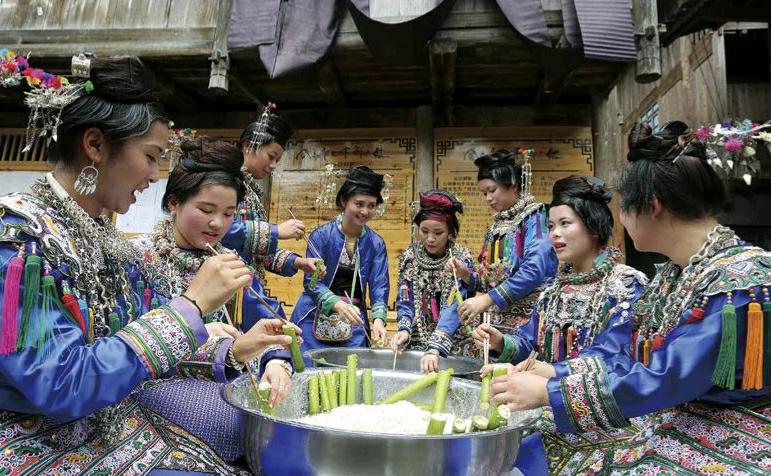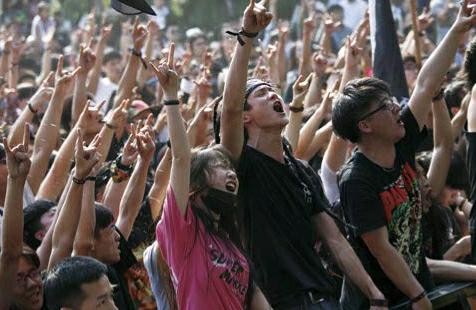Delicious Festival
2016-06-08
Women of the Dong ethnic group prepare a special treat for the Bamboo Rice Festival as part of celebration activities in Wugong Village, Rongjiang County, southwest Chinas Guizhou Province, on May 3.
Healthcare Input
China has spent 5.64 trillion yuan($871 billion) since 2009 to improve its healthcare system, according to official statistics.
The health budget for 2016 is 1.24 trillion yuan ($190 billion), said the National Health and Family Planning Commission (NHFPC) on April 28, adding that the average annual growth rate of medical input has surpassed 20 percent over the past seven years.
The ongoing healthcare reform in China aims to create a universal health security system, which focuses on equal access to basic public services for all.
The budget is also used to promote the reform and upgrading of public hospitals at or above the county level. The Central Government will grant each county 3 million yuan ($462,000) annually to accomplish the goal while providing a lump-sum of 20 million yuan($3.07 million) to every city, according to the NHFPC.
China is also making efforts to cut the financial burden of healthcare for its poverty-stricken population. According to a survey by the NHFPC and the State Councils Leading Group Office of Poverty Alleviation and Development, in 2013, 12.56 million households were in poverty directly because of unaffordable medical bills, accounting for 42.4 percent of the total number of households officially classified as poor.
Poverty Delisting
A policy to gradually remove people, villages and counties from Chinas poverty relief list was unveiled on April 28 as part of its efforts to eradicate entrenched privation.
The process will be strict and transparent and must win the recognition of the people, according to a document jointly published by the Central Committee of the Communist Party of China and the State Council, Chinas cabinet.
At the end of 2014, China had 70 million people in the countryside living below the national poverty line of 2,300 yuan ($354) in annual income. The country aims to eliminate poverty by 2020, when its 13th Five-Year Plan is completed.
According to the document, the poverty delisting process should reflect the real situation; those who are above the standard of “stable”should be delisted, while newly added poor people and those who slip back into poverty should be included so that they gain access to poverty relief programs.
It states that poverty delisting should be open and should have complete and auditable paperwork in preparation for third-party assessment and supervision.
The State Council and local governments will carry out regular and random inspections, and should any significant errors arise, those responsible will be held to account, according to the document.
Law on NGOs
China hopes for a positive and objective attitude from relevant countries toward its new law on regulating overseas NGOs, Foreign Ministry spokeswoman Hua Chunying said on April 29.
According to the law, which was adopted by the Standing Committee of the National Peoples Congress, Chinas top legislature, on April 28, overseas NGOs must secure approval from Chinese authorities before they can operate on the Chinese mainland.
This applies whether they are planning to open permanent offices or operate temporarily.
The Ministry of Public Security(MPS) and provincial police departments will be responsible for registration and regulation. Overseas NGOs operating on the mainland without approval will be punished.
The law will take effect on January 1, 2017.
Hua said the law aims to guide and regulate the activities of overseas NGOs and protect their legal rights and interests in China.
Governments at all levels will be obligated to accommodate the legal operation of overseas NGOs, providing necessary assistance and services. NGOs will enjoy preferential tax policies, according to the law.
China has accepted opinions from many different sides in the process of drafting the law and made some amendments to relevant clauses, said Hua, stressing that the management of overseas NGOs varies with different national conditions.
According to the law, NGOs must meet several criteria to set up offices on the mainland. For instance, they must have been legally founded outside the Chinese mainland, be able to bear civil liability independently and have been operational for at least two years.
NGOs shall not undermine the countrys unity, security or ethnic solidarity, nor harm the interests of the state, public or the legal rights of citizens and other groups.
They will be banned from engaging in or sponsoring commercial, political and religious activities.
No Gender Selection
Individuals and organizations that conduct medically inessential prenatal sex discernment or sex-selective abortions will be fined up to 30,000 yuan ($4,600), under a revised regulation that came into effect on April 30.
Besides a fine, the government will confiscate the income generated from such screenings and abortions, which are illegal in China.
Those who induce expectant parents to take up illegal prenatal sex discernment and selective abortions will also face the same punishment, according to the regulation, which was jointly issued by the National Health and Family Planning Commission, the State Administration for Industry and Commerce as well as the China Food and Drug Administration.
Advertisers will also be punished for publishing adverts for illegal prenatal sex discernment and selective abortion services. The prevention of illegal prenatal sex discernment and selective abortions will be taken into account in family planning officialsperformance assessments.
The revision has been made to tackle Chinas high gender imbalance, which is a direct result of pre-birth sex discernment and sex-selective abortions driven by a cultural preference for boys.
Chinas sex ratio at birth stood at 113.51 boys for every 100 girls in 2015, much higher than an international accepted normal level of 103 to 107, though it had decreased from 121.18 in 2004.
Social Organizations
China had 664,841 registered social organizations at the end of March, the Ministry of Civil Affairs said on April 30.
The registered organizations include 329,000 social groups, 4,841 foundations and 331,000 private non-enterprise entities, according to the ministry.
Private non-enterprise entities include schools, hospitals, elderly care centers and museums that are established without state assets by enterprises, public service institutions, social organizations, other community organizations or individual citizens for the purpose of engaging in non-profit service activities.
“Private non-enterprise entities, with their rapid development, have played a critical role in social undertakings,” said Huang Ru, deputy head of the Social Organization Management Bureau under the Ministry of Civil Affairs.
According to Huang, private non-enterprise entities will be renamed social service agencies after the Charity Law takes effect in September, and they will take part in charitable activities through providing free professional services to the disabled, the poor and the elderly.
Wetland Parks
The State Forestry Administration has agreed to provide financial and promotional support for four new wetland parks in southwest Chinas Tibet Autonomous Region.
The approval of the parks in Qamdo City, Shannan Prefecture and Nagqu Prefecture brings the number of state-backed wetland parks in Tibet to 14, said Zhang Hucheng, Deputy Director of the Wildlife Protection Section at the regions Forestry Department.
The new parks cover 15,400 hectares.
“Establishing more wetland parks will help us protect water resources and biodiversity,” Zhang said.
With over 6.5 million hectares of wetland, Tibet has more than 5 percent of the total area of such habitat in China.
The Tibet Regional Government has allocated 48 million yuan ($7.3 million) for the 2016-18 period to compensate local communities for their contribution to the protection of the wetlands.
Cheers for Tunes
Music fans rock up at the Taihu Midi Music Festival in Suzhou, Jiangsu Province, on April 30.
The three-day event drew about 100 bands and musicians from China and abroad.
VAT Scheme Completed
China has replaced all business tax with value-added tax (VAT) after extending the policy to cover the construction, real estate, finance and consumer services sectors on May 1.
They were the last four sectors still taxed based on their revenue.
VAT refers to a tax levied on the difference between a commoditys pre-tax price and its production cost. Revenue tax refers to a levy on a businesss gross revenue.
The expansion of the VAT scheme is expected to ease tax burdens by more than 500 billion yuan($76.9 billion) this year.
Chinas service sector is increasingly picking up the slack of manufacturing, as the worlds second largest economy is shifting toward more sustainable growth driven chiefly by consumer demand.
Expanding VAT to more service sectors is also part of the supplyside structural reforms authorities have been promoting since last year to address the structural imbalances in the Chinese economy.
The VAT scheme first started in 2012 as a pilot program in Shanghai, covering a number of services including transportation, IT and logistics. It was later expanded nationwide and covers other businesses.
Over the past four years, the VAT scheme has saved businesses 640 billion yuan ($98.5 billion) in taxes.
PMI Expansion
Chinas manufacturing activity expanded slower than expected in April, official data showed on May 1.
The purchasing managersindex (PMI) came in at 50.1 in April, slightly down from Marchs 50.2, according to the National Bureau of Statistics (NBS) and the China Federation of Logistics and Purchasing (CFLP).
A reading above 50 indicates expansion, while a reading below 50 reflects contraction.
NBS statistician Zhao Qinghe said the countrys manufacturing activity kept steady growth in April, partly due to a recovering housing market and accelerated infrastructure construction.
The PMI tracking Chinas iron and steel sector increased for the fifth consecutive month to 57.3 in April, up 7.6 percentage points from March.
It is the highest monthly reading since March 2013 and also the first time the index has climbed above 50 in two years, indicating the expansion of the steel industry, according to the CFLP.
On the other side, business activity in Chinas non-manufacturing sector expanded more slowly in April.
The PMI for the non-manufacturing sector stood at 53.5 in April, down from 53.8 in March and well above the 50 mark that separates expansion and contraction.
The non-manufacturing PMI tracks business activities of both the service sector and the construction industry.
The service sector sub-index was 52.5 in April, down 0.6 points from March.
Eye-Opening Moment
Tourists visit the Zhuhai Chimelong Ocean Kingdom, a theme park on Hengqin Island, Guangdong Province, on April 30.
During the May Day holiday (April 30-May 2), streams of travelers flooded into the China (Guangdong) Pilot Free Trade Zone, part of which is located on Hengqin, for sightseeing.
Animation Festival
Chinas biggest animation event concluded on May 2, having generated a record 15.1 billion yuan($2.3 billion) in contracts and sales, according to the events organizing committee.
The 12th China International Cartoon and Animation Festival, held in Hangzhou, capital of east Chinas Zhejiang Province, is a major barometer for Chinas cartoon and animation industry.
The revenue figure, which comprises 12.9 billion yuan ($1.98 billion) in contracts and 2.2 billion yuan ($338.5 million) in consumption at the fair, surpassed last years 14.8 billion yuan ($2.28 billion) despite a campaign to cut overcapacity in the animation industry. China produced 134,000 minutes of TV animation in 2015, which was about half the volume produced in 2011.
In the movie sector, box office revenues of domestic animation films surged 78.6 percent to reach more than 2 billion yuan ($308 million) last year, gradually catching up with the 2.3 billion yuan ($354.14 million) pulled in by imported films, according to a report released at the festival.
The six-day event was attended by 1.38 million people, including more than 1,500 companies and institutions from China and abroad, and displayed 320 animation products.
A Pageant for Traders
A visitor examines car-shaped suitcases for children at the 119th China Import and Export Fair, known as the Canton Fair, in Guangzhou, Guangdong Province on May 1.
The third-phase of the biannual Canton Fairs spring session was held from that day to May 5.
Local Cooperation
Chinese ride-hailing company Didi is eying an alliance with peers abroad for its global expansion strategy, the company founder said.
“Demand for transportation services varies among different markets, and local companies are better positioned to meet these needs,”said Didi founder and CEO Cheng Wei during a panel discussion at tech conference GMIC Beijing 2016, which took place from April 28 to May 2.
“When we leave China, we seek to share our technological abilities with our partners to make their transportation services more efficient,”Cheng said.
Unlike its rival, Uber, which operates in 400 cities worldwide, Didi has invested in Ubers local rivals such as Lyft in the United States, Grab in Southeast Asia, and Ola in India. The group forms what Cheng called“a Star Alliance for ride-hailing services,” as local firms know best how to serve customers in their markets.
Cheng said real dominance in Internet-based transportation services is not just a matter of scale, it is about sharpening an edge in big data, cloud computing and other areas to meet transportation needs.
“Its a very local game,” said Anthony Tan, CEO and co-founder of Grab, during the panel discussion.
Tan added that motorcycle ride services in some of Grabs Southeast Asia markets have proved popular as the bikes can wind through heavy traffic.
Inaugural Transit
China COSCO Shipping won a draw on April 29 to inaugurate the Expanded Panama Canal this June with one of its mega vessels, the Panama Canal Authority (ACP) announced.
“The shipping lines container vessel, Andronikos, will be making the inaugural transit,” the ACP said in a press release.
The draw, which took place on April 29 at the Panama Canal Administration Building, pitted the Norwegian/Swedish shipping line Wallenius Wilhemsen Lines against China COSCO.
More than 100 cargo ships too large for the canal prior to its widening have already made reservations for commercial transit through the new larger locks beginning from June 27, the day after the historic inauguration, the ACP said.
The Panama Canal announced in March it would invite its top customers to participate in the draw.
Electric Taxis Promoted
The northern Chinese city of Taiyuan is aiming to replace all of its gasoline-powered taxis with electric ones by the end of 2016 in order to cut emissions.
In February, Taiyuan, capital of coal-rich Shanxi Province, started scrapping its 8,292 conventional taxis, replacing them with electric ones. More than 3,000 electric taxis are now in operation on Taiyuans roads.
The new taxis can cover 400 km on a full charge, which takes two hours, Qin said.
They are priced at around 310,000 yuan ($48,000). Taxi drivers are being asked to contribute 90,000 yuan ($13,850), with the central and local governments paying the rest.
Taiyuan currently has more than 500 charging posts and plans to increase that number to 5,000 by the end of 2018.
Innovation
Co-founder of 700Bike.com Zhang Xiangdong (right) tries his product at the 10th edition of re:publica, a conference on Internet and society, in Berlin, Germany, on May 2.
